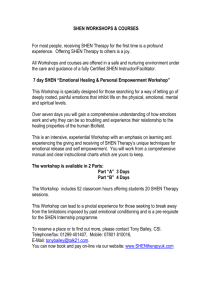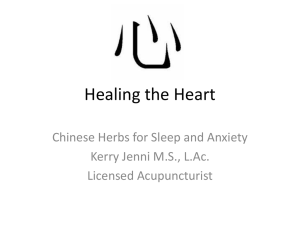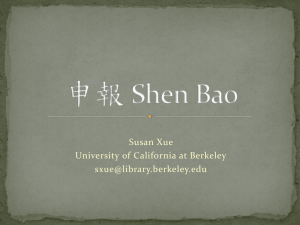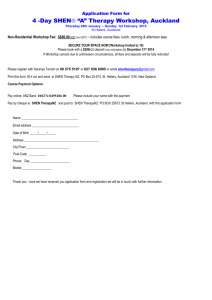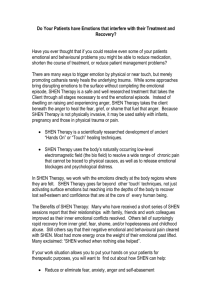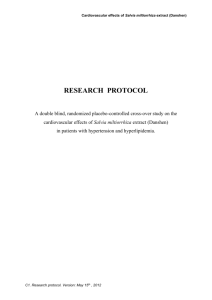Herbal pharmacology and Drug interaction of the Herbs that
advertisement
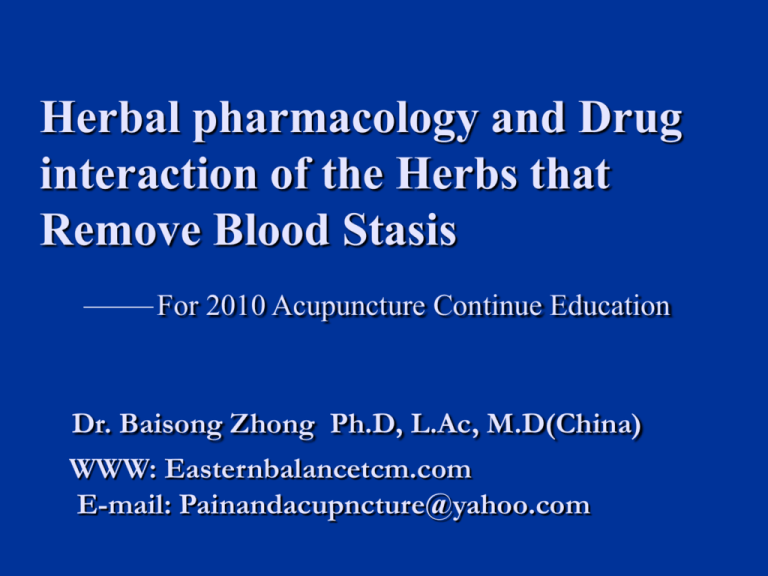
Herbal pharmacology and Drug interaction of the Herbs that Remove Blood Stasis For 2010 Acupuncture Continue Education Dr. Baisong Zhong Ph.D, L.Ac, M.D(China) WWW: Easternbalancetcm.com E-mail: Painandacupncture@yahoo.com Introduction of Herbal pharmacology and Drug Interaction of the Herbs that Remove Blood Stasis 1. Actions of the herbs (1,2,3) (1) Improve the microcirculation Blood stasis is the most common pathogenesis of disorders of microcirculation, such as coronary heart disease, cerebral diseases. This group herbs can improve the fluid, state, permeability of microcirculation. (2)Improve hematology and against coagulation Blood stasis is related to thrombus formation due to “thickness, stickiness, coagulation and accumulation” of blood in circulation. Most of the herbs that remove blood stasis have excellent function of improving the tendency of “thickness, stickiness, coagulation and accumulation” of blood in circulation. They have inhibitory influence on thrombus formation, and are used in treatment of angina, embolism and stroke. The herbs include Dan Shen(Radix Salviae Mitiorrhizae), Chuan Xiong(Rhizoma Ligustici Chuanxiong), Hong Hua(Flos Carthami). (3)Dilate blood vessel and increase blood perfusion to small vessels. The herbs that dilate coronary arteries include Shui Zhi(Hirudo), E Zhu(Rhizoma Curcumae), Tao Ren(Semen Persicae), Chuan Xiong(Rhizoma Ligustici Chuanxiong) (4)Antineoplastic: Some of the herbs can inhibit the growth of cancer cells in vitro. The examples are San Leng(Rhizoma Sparganii), E Zhu(Rhizoma Curcumae), Sanqi (Panax notoginseng). (5)Lower cholesterol The herbs are Sanqi (Panax notoginseng), Dan Shen (Radix Salviae Mitiorrhizae), Pu Huang(Pollen Typhae). 2. Potential Herb-drug Interactions (3) (1)Antiplatelets and anticoagulants: The group herbs may enhance the actions of antiplatelets and anticoagulants medications, and prolong bleeding, such as warfarin, heparin, lepirudin, salicylate . (2)Antihypertensives: Some of the group of herbs may dilate the blood vessels, which may potentiate the effect of antihypertensiv medications. Reference 1.Qian Xin-zhong. Chinese Materia Medica. People’s Medical Publishing House. 2007.Beijing 2. Shen Yin-jun. Chinese Herbal Pharmacology. People’s Medical Publishing House. 2000.Beijing 3. John Chen, Tina T Chen. Chinese Medical Herbology and Pharmacology. Art of Medicine Press, Inc. 2009. City of Industry, CA. Dan Shen(Radix Salviae Mitiorrhizae) News Dan shen BEIJING, Aug. 7 (Xinhua) -- A China-made pill to treat cardiovascular conditions has been tested safe and effective by the U.S. Food and Drug Administration (FDA), and, hopefully, will be marketed in the U.S. as early as 2013, a pharmaceutical company said here Saturday. (http://news.xinhuanet.com/english2010/china/2010-08/07/c_13434173.htm) FDA reports: Dan Shen and Ge Gen are in clinical trialPhase II: Cardiovascular-Protective Effects of Herbal Medicine Danshen-Gegen(http://clinicaltrials.gov/ct2/show/NCT01033630?term=Danshen&rank=1) Dan shen Dan Shen is the root and rhizome of salvia miltiorrhiza Bge., family Labiatae. Properties: Bitter and slightly cold Channels entered: Heart, pericardium, and liver 1. Actions and indications (1) Actions and indications in TCM (1) Invigorates the blood and breaks up blood stasis: It is used for blood stasis disorders in lower abdomen such as dysmenorrhea, amenorrhea, masses. It is also used for Chest pain. Dan shen (2)Clears heat and smoothes irritability It is used for restlessness, irritability, palpitation. (3)Cools blood and expels pus It is used for heat in the blood level, skin sores due to toxic heat. Dan shen 2. Chemical Ingredients in Danshen(2,3,4) Dan Shen has more than 50 compounds: TanshinoneⅠ, TanshinoneⅡA, Tanshinone ⅡB, Cryptotanshinone, Cryptotanshinone, Danshensu(Salviania acid A), IsotanshinoneⅠ, IsotanshinoneⅡ, Isocryptotanshinone, TanshinolⅠ, TanshinolⅡ. Methyl tanshinonate, hydroxytanshinone ⅡB , Vitamine E. Dan shen 3.Pharmacokinetics (5) Major components absorbed rapidly after oral administration Metabolized extensively by liver Excreted from stool and urine, Some components have low short half life, low bioavailability, because of extensive metabolism Dan Shen 4. Actions and indications in Herbal pharmacology Danshensu(6,7,8,9) Dilates coronary arteries, inhibits platelet aggregation, improves microcirculation, and protects the myocardium from reperfusion injury of the ischemic heart. Mechanisms: - prevent intracellular calcium increase - remove oxygen free radicals - Inhibit myocardial cell apoptosis - protect the endothelial cells against homocysteinemia (risk factor for cardiovascular diseases and atherosclerosis) Dan shen Salvianolic Acid B(10, 11) Protect the brain from ischemia-reperfusion injury Mechanisms: -Inhibit platelet aggregation and oxidative modification of lowdensity lipoprotein(LDL), leading to the prevention of the uptake of LDL(12,13). -Inhibit erythrocyte hemolysis and lipid peroxide production(14) -Inhibit DNA synthesis of noncardiomyocytes and inhibit stress-activated protein kinase activity, leading to protection of ischemia-reperfusion injury (15) Dan shen Tanshinone IIA Reduce myocardial infarct size(16). -Inhibit LDL oxidation and angiotensin II activity, resulting in attenuation of cardiac cell hypertrophy. The other actions: Prevent cancer metastasis(17) Tanshinone II-A significantly inhibited in vivo metastasis of colon carcinoma SW480 cells. It inhibited in vitro and in vivo invasion and metastasis of colon carcinoma cells by reducing levels of urokinase plasminogen activator (uPA) and matrix metalloproteinases (MMP)-2 and MMP-9, and by increasing levels of tissue inhibitor of matrix metalloproteinase protein (TIMP)-1 and TIMP-2. Tanshinone II-A was also shown to suppress the nuclear factor-kappaB (NF-kappaB) signal. Dan shen Protect the liver injury(18) Clinic researches: 1. Angina Pectoris -Danshen products were found to be better than isosorbide dinitrate(ISDN) for long term use -None of the Danshen products was found to be superior in efficiency to nitroglycerin, fewer side effects such as headache were found in Danshen group compared to that in the nitroglycerin group(19). -Danshen dripping pill was found to achieve a higher rate of effectiveness in treating patients with angina pectoris in comparison to the Danshen Tablet. -Fufang Danshen Spray and injection were similar or better efficacy when compared to ISDN(20) Dan shen -The improvement of exercise ECG from the Fufang Danshen Dripping Pill was found to be significantly better than ISDN. -The sublingual Fufang Danshen Dripping Pill is at least as effective as sublingual ISDN and comparable to sublingual nitroglycerin(21) 2. Hyperlipidemia(22) -Danshen products can reduce the level of cholesterol, triglyceride, and LDL, and raised the level of HDL. Dan shen 3. Acute Ischemic Stroke (23,24) -Improve the short-term effect of acute stroke patients -conducive to the recovery of patients with traumatic intracranial hematoma (TICH) -improves the microcirculation of femoral head, which is beneficial to repair and reconstruction of femoral head. Dan shen Side effects (25) No major side effects Patients who are taking Fufang Danshen Dripping Pill may felt thirsty(3/100), dizziness, drowsiness, abdominal discomfort(2/34), decrease appetite and itching. LD50 of water soluble extract was almost 4000 times higher in mice than the clinical human oral dosage. Dan shen HERB-DRUG INTERACTION 1. The anticoagulant response to warfarin could be exaggerated when coadministered with Danshen (26,27). 2. Salicylate in therapeutic concentration was reported to be significantly decrease free Danshen concentration as measured by freedigoxin-like activity(28) DOSAGES: 1. Loose Danshen: 6-15g 2. Fufang Danshen Dripping Pill: 10 pills orally or sublingually each time, 3 times daily 3. Fufang Danshen Tablets 3 tablets orally each time, 3 times a day. Dan shen 1.Qian Xin-zhong. Chinese Materia Medica. People’s Medical Publishing House. 2007.Beijing 2. Zhou L , Zuo Z , Chow MS . Danshen: an overview of its chemistry, pharmacology, pharmacokinetics, and clinical use . J Clin Pharmacol . 2005;45(12):1345-1359. 3. Wang X , Morris-Natschke SL , Lee KH . New developments in the chemistry and biology of the bioactive constituents of Tanshen . Med Res Rev . 2007;27(1):133-148. 4. Jiang RW , Lau KM , Hon PM , Mak TC , Woo KS , Fung KP . Chemistry and biological activities of caffeic acid derivatives from Salvia miltiorrhiza . Curr Med Chem . 2005;12(2):237-246. 5. Ye G, Wang CS, Li YY, Ren H, Guo XM. Simultaneous determinationand pharmacokinetic studies on (3,4-dihydromxyphenyl)-lactic acid and protocatechuic aldehyde in rat serum after oral administration of Radix Salvia miltiorrhiza extract. J Chromatogr Sci. 2003;41:327-330 6.Dong ZT, Jiang WD, Effect of Danshen of isolated swine coronary artery perfusion preparation. Yaoxue Xuebao. 1982;17:226-228 7. Li CZ, Yang SC, Zhao FD, et al. Anticoagulant Studies of Danshen. Zhongxiyi Jiehe Zazhi.1983;3:297-299 Dan shen 8. Dong C, Wang Y, Zhu YZ. Asymmetric synthesis and biological evaluation of Danshensu derivatives as anti-myocardial ischemia drug candidates. Bioorg Med Chem. 2009 May 1;17(9):3499-507. 9.Wu L, Qiao H, Li Y, Li L. Protective roles of puerarin and Danshensu on acute ischemic myocardial injury in rats. Phytomedicine. 2007 Oct;14(10):652-8. Epub 2007 Sep 17. 10. Chen YH , Du GH, Zhang JT. Salvianolic acid B protects Brain against injuries caused by ischemia-reperfusion in rats. ZhongGuo Xinyao Zazhi. 2000:21:463-466. 11. He HB, Yang XZ, Shi MQ, et al. Comparison of cardioprotective effects of salvianolic acid B and benazepril on large myocardial infarction in rats. Pharmacol Rep. 2008 May-Jun;60(3):369-81. 12. Han JY, Fan JY, Horie Y, et al. Ameliorating effects of compounds derived from Salvia miltiorrhiza root extract on microcirculatory disturbance and target organ injury by ischemia and reperfusion. Pharmacol Ther. 2008 Feb;117(2):280-95. 13. Tang MK, Ren DC, Zhang JT, et al. Effect of salvianolic acids from Radix Salviae miltiorrhizae on regional cerebral blood flow and platelet aggregation in rats. Phytomedicine. 2002 Jul;9(5):405-9. 14. Yang TL, Lin FY, Chen YH, et al. Salvianolic acid B inhibits low-density lipoprotein oxidation and neointimal hyperplasia in endothelium-denuded hypercholesterolaemic rabbits. J Sci Food Agric. 2010 Sep 7. 15.Ouyang XS, Takahashi K , Komatsu K, et al. Protective effects of Salvia miltiorrhiza on angiotension II-indued hypertrophic responses in neonatal cardiac cells. Jpn J Phamarcol. 2001;87:289-296. Dan shen 16. Wu TW, Zeng LH, Fung KP, et al. Effect of sodium tanshinone IIA sulfonate in the rabbit myocardium and on human cardiomyocytes and vascular endothelial cells. Biochem Pharmacol. 1993;46:2327-2332. 17. Shan YF, Shen X, Xie YK, et al. Inhibitory effects of tanshinone II-A on invasion and metastasis of human colon carcinoma cells. Acta Pharmacol Sin. 2009; 30:1537-1542. 18. Chor SY, Hui AY, To KF, et al. Anti-proliferative and pro-apoptotic effects of herbal medicine on hepatic stellate cell. J Ethnopharmacol. 2005 Aug 22;100(12):180-6. 19. Wang YY, Wang H. comparison of dissolving compound Salvia miltiorrhiza in mouth and dissolving nitroglycerin in mouth to treat angina pectoris. Henan Zhigong Yixueyuan Xuebao. 2004;16:227-229. 20.Guan ZX, Zhang XQ. Curative effects of composite Salvia miltiorrhiza bunge complex aerosol on ischemic angina pectoris. Zhonggou Zhongxiyi Jiehe Zazhi. 2000;4:284. 21. Ding XM, Lia LZ, Wang CH. Curative effect of Danshen composite on stable angina ppectoris. Zhongguo Linchuang Yixue.1999;6:21-22. Dan shen 22. Shao M. Clinic observation of Salvia miltiorrhiza injection on ubstable anginapectoris. Anhui Zhongyi Xueyuan Xuebao. 2003;22:13-15 23. Sun M, Zhang JJ, Shan JZ, et al. Clinical observation of Danhong Injection (herbal TCM product from Radix Salviae miltiorrhizae and Flos Carthami tinctorii) in the treatment of traumatic intracranial hematoma. Phytomedicine. 2009 Aug;16(8):6839 24. Huang X, Jian H, Liu D, et al. Implantation of calcium phosphate cement/Danshen drug delivery system for avascular necrosis of femoral head. Zhongguo Xiu Fu Chong Jian Wai Ke Za Zhi. 2008 Mar;22(3):307-10. 25. Zhou JZ, Xiong P. Clinical observation of composite Danshen dipping pill on 100 patients with coroary heart disease. Linchuang Yi yao Shijiang Zazhi. 2003;12:264265. 26. Liu J, Wang X, Cai Z, et al. Effect of tanshinone IIA on the noncovalent interaction between warfarin and human serum albumin studied by electrospray ionization mass spectrometry. J Am Soc Mass Spectrom. 2008; Oct: 1568-75 27. Chan TY. Interaction between warfarin and Danshen. Ann Pharmacother. 2001;35:501-504. 28. Gupta D, Jalali M, Wells A, et al. Drug-herb interactions: unexpected suppression on free Danshen concentrations by salicylate. J Clin Lab Anal.2002;16:290-294 Sanqi (Panax notoginseng) Sanqi The root of Panax Notoginseng It is the largest ingredient in 云南白药 (Yunnan Bai Yao), a famous hemostatic herbal remedy Sweet and slightly bitter in taste, and nontoxic. The dose in decoction for clinical use is 5-10 g. It can be ground to powder for swallowing directly or taking mixed with water: the dose in that case is usually is 1-3 grams. Sanqi 1. Action and Indications in TCM (1) Stops bleeding and transforms blood stasis: Used for internal and external bleeding (2) Reduces swelling and alleviates pain: Sanqi 2. Chemical constituents. Saponins derivatives (PNS), which is a mixture of more than 20 types of saponins, four or five of them are considered as the principle active ones Notoginenoside R1, ginsenoside Rg1, Rd, Re and Rb1 (75-80% total PNS) Flavonoids et al. Sanqi 3. Pharmacokinetics Oral administration, most Saponins derivatives (powder) tested in rats, reached peak concentration in plasma rapidly within about 0.75 h - hint their absorption were quick. Maximum concentration in rat plasma were low indicated that it may be poorly absorbed and / or extensive metabolized (intestinal microflora, liver) San-qi Half time was changed from 1 to 20 hrs in rat plasma after oral administration of the constituents Iv in rats, most constituents were cleared quickly except a couple of PNS the pharmacokinetic profile diversities of these constituents are probably one of the mechanisms of the multiple pharmacology activities San-qi 4. Actions and indications in Herbal pharmacology (1)Hemostatic effect San-qi and a saponin (PNS) extract provide hemostatic effects. External application reduces bleeding time(1). San-qi (2)Thrombogenicity effects PNS reduces platelet activation, adhesion and aggregation(2). Prevent thrombosis and improve microcirculation in patients with blood hyperviscosicity syndrome(3). San-qi (3)Thrombogenicity effects PNS iv or oral 200 mg/kg need 20 days to appear hint a slow effect compare to hemostatic San-qi (4)Fibrinolytic effects Sanqi (the extract as notoginsenoside R1) increased the fibrnolytic potential in in vivo lab test, which may be beneficial to cardiovascular disease(4) San-qi (5)Cardiovascular effects Dilate the coronary artery, increase coronary blood flow, providing more blood to the heart muscle Improves micro-circulation in and around damaged heart tissue Reduces cardiac load, lowers arterial pressure(5) San-qi Decrease the size of myocardial infarction Anti-arrhythmia PNS increases PGI2 and reduces thromboxane A2 in platelets – correct the unbalance between the two prostaglandins San-qi (6)Anti-atherosclerotic effect It helps lower cholesterol and triglycerides, to prevent the progression of atherosclerotic lesion. PNS possess antihyperglycemic and anti-obese activities by improving insulin- and leptin sensitivity, and Rb1 is responsible for the antihyperglycemic effect among the five saponins in KK-Ay mice.(6, 7) (7)Effects on brain San-qi Protect ischaemic brain damage(8). Ginsenoside Rb(3) could markedly protected OGD-Rep induced ischemic injury and the mechanisms maybe related to its suppression of the intracellular Ca(2+) elevation and inhibition of apoptosis and caspase activity. Ginsenoside Rb(3) could be a promising candidate in the development of a novel class of anti-ischemic agent. Decrease brain edema, infarct size and neuron damage Inhibit uptake calcium by neuron cells isolated from rats Protect cultured rat cortical neuron from glutamate neurotoxicity(9) San-qi (8)Tumor Radio-sensitivity Taiwanese scientists studied the sensitization effect of Panax notoginseng extract and purified Saponin (Rb1) on the radiation response of an experimental tumor (KHT sarcoma) in comparison with its effects on a normal tissue (bone marrow) in mice. San-qi Panax notoginseng extract at a concentration of 0.1-100 mg/kg produced an increase in tumor radiosensitivity. Rb1 at a concentration 0.001 to 1 mg/kg produced an increase in tumor radiosensitivity, with maximum effect at 1 mg/kg. The effect was maximal at 10 mg/kg and at 30 minutes after injection. Further purified or synthetic versions are useful in cancer therapy. (9)Anti-inflammatory effects and stop pain San Qi can stop pain caused by inflammation and trauma through anti-inflammation and disturbing the central nervous system. 5. Toxicity Low Esophagitis from consuming tablets (drink enough water) may occur Allergic reactions including dermatitis, shock, purpura, blisters, or other idiosyncratic reactions. 6. Clinical research (1)Coronary artery disease (2)Hyhercholesterolemia (3)Bleedings: Upper gastointerestinal bleeding Stomach bleeding Hemoptysis Pain Reference: Sanqi 1.Fan C, Song J, White CM.A comparision of the hemostatic effects of notoginseng and yun nan bai yao to placebo control. J Herb Pharmacother. 2005;5(2):1-5. 2. Lau AJ, Toh DF, Chua TK, et al. Antiplatelet and anticoagulant effects of Panax notoginseng: comparison of raw and steamed Panax notoginseng with Panax ginseng and Panax quinquefolium. J Ethnopharmacol. 2009 Sep 25;125(3):380-6. Epub 2009 Aug 7. 3.Wang J, Xu J, Zhong JB. Effect of Radix notoginseng saponins on platelet activating molecule expression and aggregation in patients with blood hyperviscosity syndrome. Zhongguo Zhong Xi Yi Jie He Za Zhi. 2004 Apr;24(4):312-6. 4.Zhang WJ, Wojta J, Binder BR. Effect of notoginsenoside R1 on the synthesis of components of the fibrinolytic system in cultured smooth muscle cells of human pulmonary artery. Cell Mol Biol. 1997 Jun;43(4):581-7. 5. Wu L, Zhang W, Tang YH, et al. Effect of total saponins of "panax notoginseng root" on aortic intimal hyperplasia and the expressions of cell cycle protein and extracellular matrix in rats. Phytomedicine. 2010 Mar;17(3-4):233-40. Sanqi 6.Yang CY, Wang J, Zhao Y, et al. Anti-diabetic effects of Panax notoginseng saponins and its major anti-hyperglycemic components. J Ethnopharmacol. 2010 Jul 20;130(2):231-6. 7.Liu G, Wang B, Zhang J, et al. Total panax notoginsenosides prevent atherosclerosis in apolipoprotein E-knockout mice: Role of downregulation of CD40 and MMP-9 expression.J Ethnopharmacol. 2009 Nov 12;126(2):350-4. 8. Zhu JR, Tao YF, Lou S, et al. Protective effects of ginsenoside Rb(3) on oxygen and glucose deprivation-induced ischemic injury in PC12 cells. Acta Pharmacol Sin. 2010 Mar;31(3):273-80. 9. Cai BX, Li XY, Chen JH, et al. Ginsenoside-Rd, a new voltage-independent Ca2+ entry blocker, reverses basilar hypertrophic remodeling in stroke-prone renovascular hypertensive rats. Eur J Pharmacol. 2009 Mar 15;606(1-3):142-9. Chuan Xiong (Rhizoma Ligustici Chuanxiong) Chuan Xiong Chuanxiong is the root and rhizome of Ligusticum Chuangxiong Hort Properties: Acrid, warm. Channels entered: Liver, pericardium, and gallblader. 1. Actions and indications in TCM (1) (1)Regulate Qi and invigorates the blood It is widely used for irregular menstruation, menorrhea, dysmenorrhea, and headache due to qi stagnation and blood stasis. (2)Expel wind and relieve pain It is used for headache, aching body and Bi syndrome due to wind cold. Chuan Xiong 2. Major Chemical Ingredients(2) Alkaloids: Chuanxiongzine, tetramethylprazine, Organic acid: Ferulic acid, sedanonic acid, Essential oil: ethyl pentadecanoate, 3. Pharmacological effects(2,3) (1)Cardiovascular(4) Chuan Xiong dilates blood vessels, increases myocardial blood flow and oxygen-supply, keeps myocardial oxygen balance. The mechanism is related to ChuanXiong decreases invascular endothelial growth factor (VEGF) expression. (2). Improves the circulation Chuan Xiong Dilates arteries: dilates the arteries of the heart, brain, lungs: for example, increases blood perfusion to and reduce swelling of the brain. Used for migraine, cerebral ischemia, Alzheimer’s disease. Antiplatelet and anticoagulant: Chuan Xiong (3)Stop pain Sedative: effects on the central nervous system Relaxes the spasm of muscles (4)Others Decreases the side effects of kanamycin and cyclosporin A Anti-radiotherapy: Chuan Xiong 4. Herb-drug Interaction(2,3) Antiplatelet and anticoagulat: Though this potential interaction has not been documented, it should be used with caution. Examples of antiplatelet are aspirin, dipyridamole(persantine), and clopidogrel(plavix). Examples of anticoagulat are heparin, wafarin(coumadin), and enoxaprin(lovenox). 5. Toxicology(2,3) Chuan Xiong When continuous oral administrated in mice with 5mg-10mg/kg for 4 weeks, no abnormalities of liver, kidney, blood exam. and pathological exam were observed. The LD50 for it preparation in mice was 66.42g/kg with intravenous injection. Chuan Xiong 6. Clinical Indication of Research Headache Diseases of the heart and brain Chuan Xiong Reference: 1.Qian Xin-zhong. Chinese Materia Medica. People’s Medical Publishing House. 2007.Beijing 2. Shen Yin-jun. Chinese Herbal Pharmacology. People’s Medical Publishing House. 2000.Beijing 3. John Chen, Tina T Chen. Chinese Medical Herbology and Pharmacology. Art of Medicine Press, Inc. 2009. City of Industry, CA. 4. Meng H, Guo J, Sun Jy, et al. Angiogenic effects of the extracts from Chinese herbs: Angelica and Chuanxiong. Am J Chin Med. 2008;36(3):541-54. Thank You !
